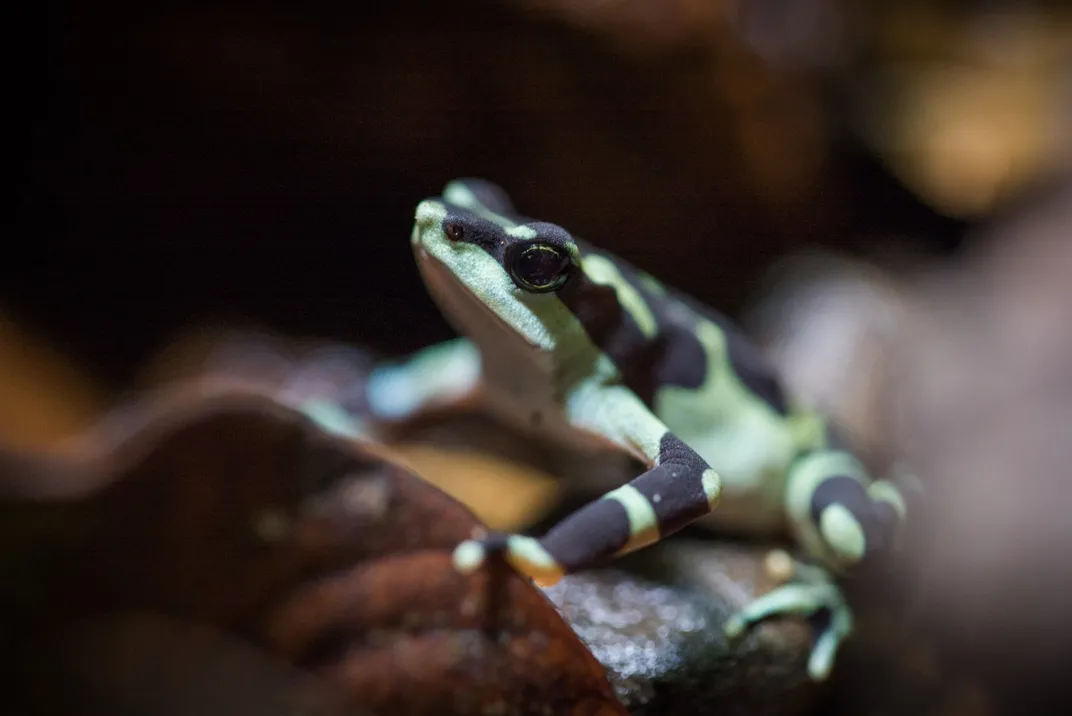NATIONAL ZOO AND CONSERVATION BIOLOGY INSTITUTE
A New Leap in the Fight to Save Frogs
Scientists identify best practices for reintroduction of endangered and extinct amphibians in a new publication.
:focal(660x120:661x121)/https://tf-cmsv2-smithsonianmag-media.s3.amazonaws.com/filer_public/b9/ac/b9aca409-ff5c-488d-b045-9baa07ae40b4/limosa-harlequin-frog-release.jpg)
Five years ago, eighty-three limosa harlequin frogs set their tiny feet upon the forest floor in the Panamanian rainforest. Through the Panama Amphibian Rescue and Conservation Project (PARC), researchers from the Smithsonian’s National Zoo and Conservation Biology Institute conducted the first-ever release trial of limosa harlequin frogs, or Atelopus limosus, which is a critically endangered species endemic to Panama. Today, a study on the trial was published in the journal Frontiers in Amphibian and Reptile Science.
Atelopus limosus has been threatened by the deadly chytrid fungus, which is believed to have caused mass amphibian extinctions on several continents. Smithsonian scientists have been searching for a solution to the disease chytridiomycosis (caused by the fungus), including studying frog skin to determine if there are beneficial, chytrid-fighting microbes. Without a way to protect amphibians from the disease, the likelihood of reintroduced animals surviving in the wild is slim. However, the team of scientists wanted to determine whether priming the animals for release could improve their chances of survival.
Led by Blake Klocke, a George Mason University Ph.D. student; Roberto Ibáñez, director of the PARC project at the Smithsonian Tropical Research Institute and Brian Gratwicke, a conservation biologist at the Smithsonian National Zoo and Conservation Biology Institute, the team returned captive-bred frogs to a tributary stream of the Mamoní River. The release site in the Mamoní Valley Preserve is an area within the frogs’ native range that lacked an existing population. Researchers inserted tiny, numbered tags under the frogs’ skin and marked the frogs’ toes with elastomer tattoos to help identify them upon recapture. Seventeen of the frogs wore radio transmitters on their backs, allowing the researchers to repeatedly track and find the animals again.
Sixty of the frogs in the study were released into the wild and dispersed quickly, with many heading away from the stream. Scientists used mesocosms, or mesh pens, to conduct “soft releases” for 23 of the frogs, essentially keeping the frogs at the initial dispersal site for several weeks. The soft release allowed the frogs to be safe from predation while getting acclimated to their new habitat. Then, these additional frogs were released into the forest.
"There was a variation in survivorship,” said Brian Gratwicke, one of the co-authors of the study. “The frogs in the mesocosms had a 46 percent chance of surviving the first 30 days compared to 31 percent for hard release animals.”
Gratwicke believes the survival rate had to do with the dispersal speed of the frogs. Even after they were removed from the mesh pens, the soft release frogs stayed in the vicinity of the stream, unlike the hard release frogs, which spread further and faster.
“When they do disperse far, they get more opportunities to get into trouble,” he said. “If you’re a frog in the forest, you could run into a snake or a whip scorpion or a spider—some of these things we observed eating the frogs. We don’t have the predation data to prove it, but my suspicion is the hard release animals were more vulnerable to predation than the soft release animals.”

Ultimately, whether by predation or chytrid, many of the frogs did not survive through the trial. Only two of the radio tracked frogs survived to the end of the 58-day period, although Gratwicke noted non-radio tracked frogs may have survived, but scientists were unable to locate them. Despite these numbers, scientists learned a great deal from this study, both in regard to the survival of the frogs and in how to conduct future release trials. It was incredibly difficult to find released animals without radio transmitters, but the transmitters posed their own challenges, too.
“If we didn’t tie it on tight enough, it could loosen and rub against the frog, causing lesions,” Gratwicke explained. “Then we would need to release the frog and remove it from the study. We were also able to see that regular mark recapture wasn’t a suitable method for studying released Atelopus because the recapture rates are so low. So, we need to rethink our mark recapture methodologies. This was all part of the learning curve.”
Armed with a better understanding, the team hopes to conduct more release trials in the future once more solutions to chytrid have been developed.
“We’ve seen chytrid fungus doesn’t spike just because we released these susceptible frogs into the wild. Moving forward, we would like to try a vaccination trial, we want to see if we can selectively breed chytrid-resistant frogs. Those are two strategies we’re going to be testing at some stage in future trials,” Gratwicke said. “But now, we’ve got to do the lab work and get good numbers of the frogs up.”


